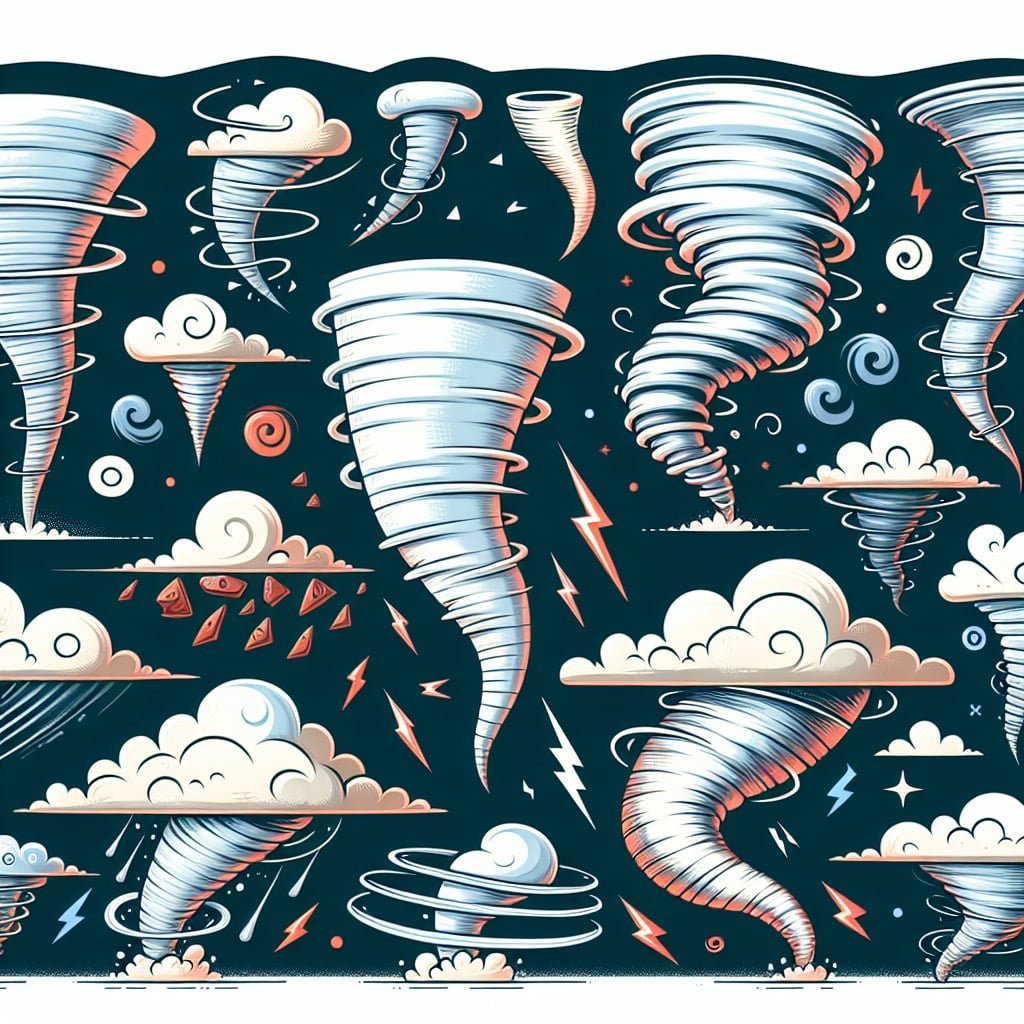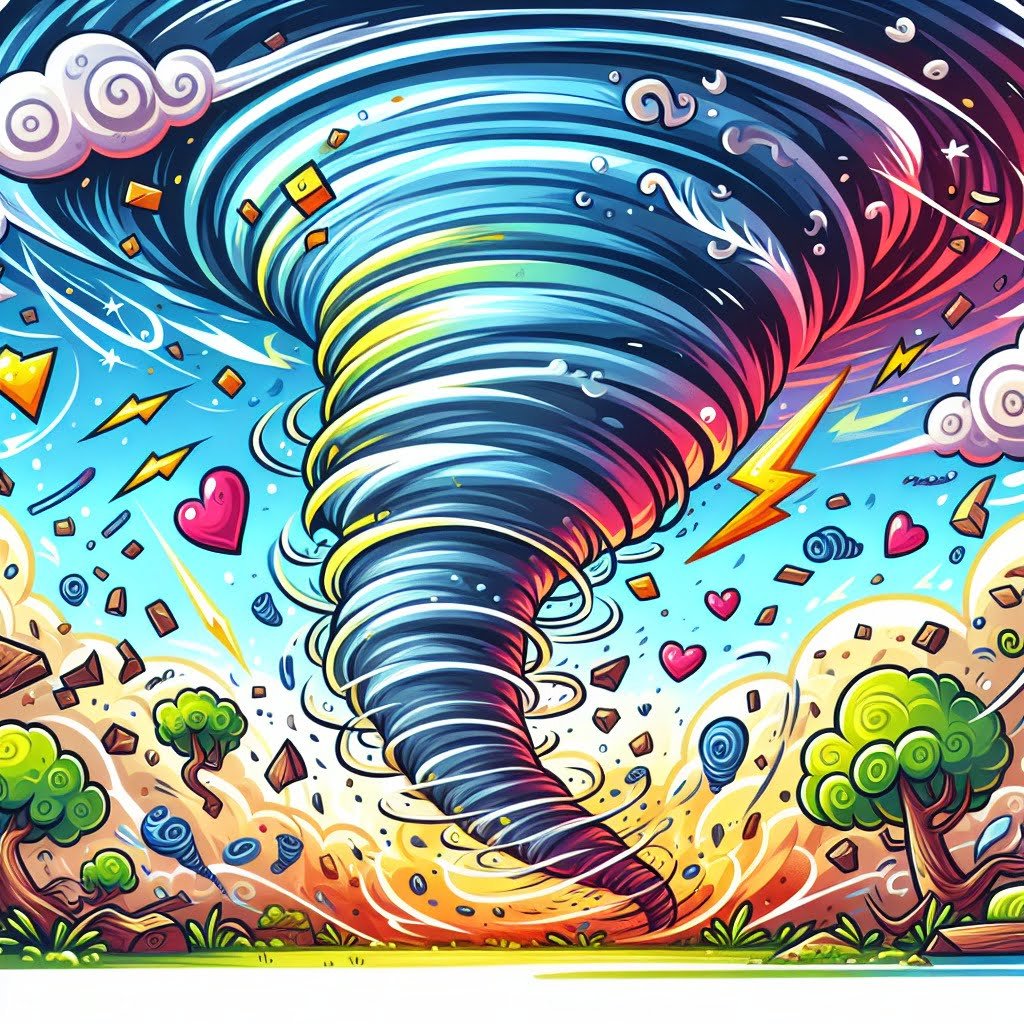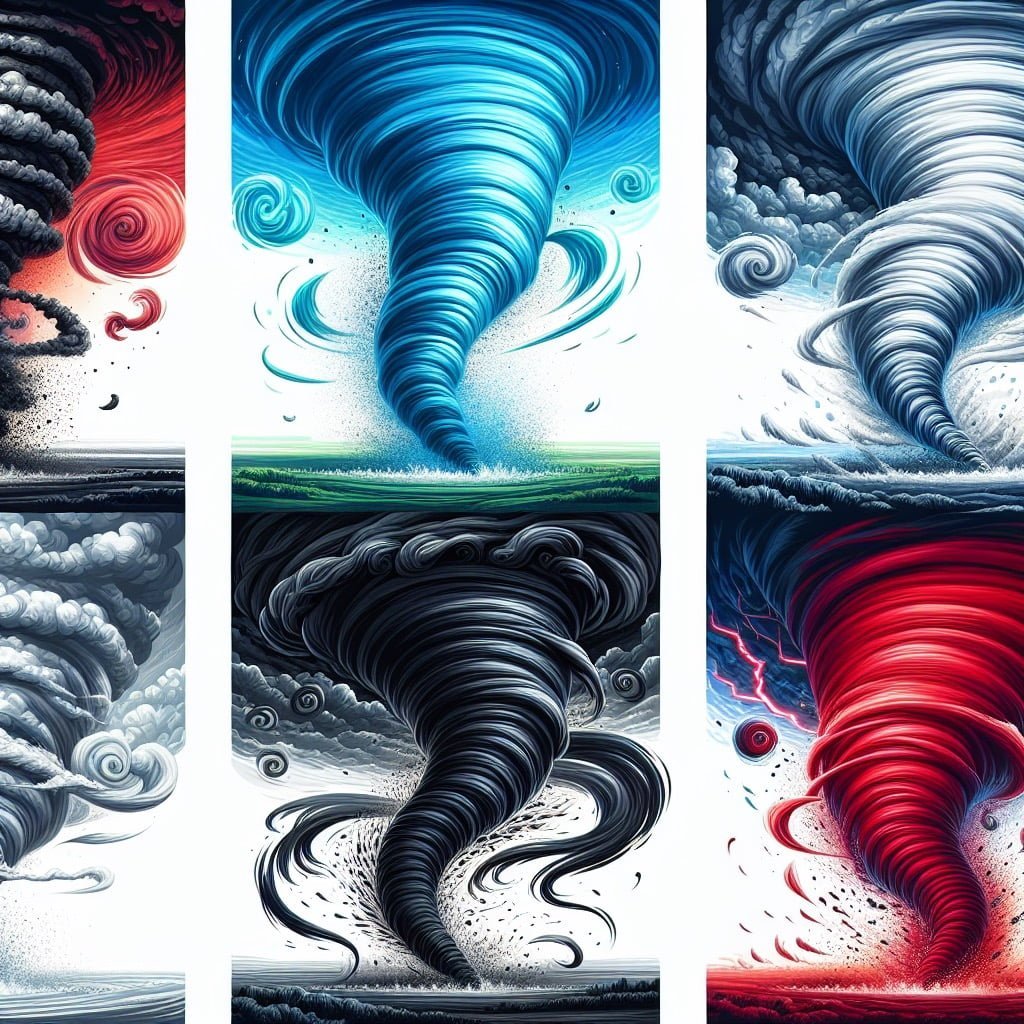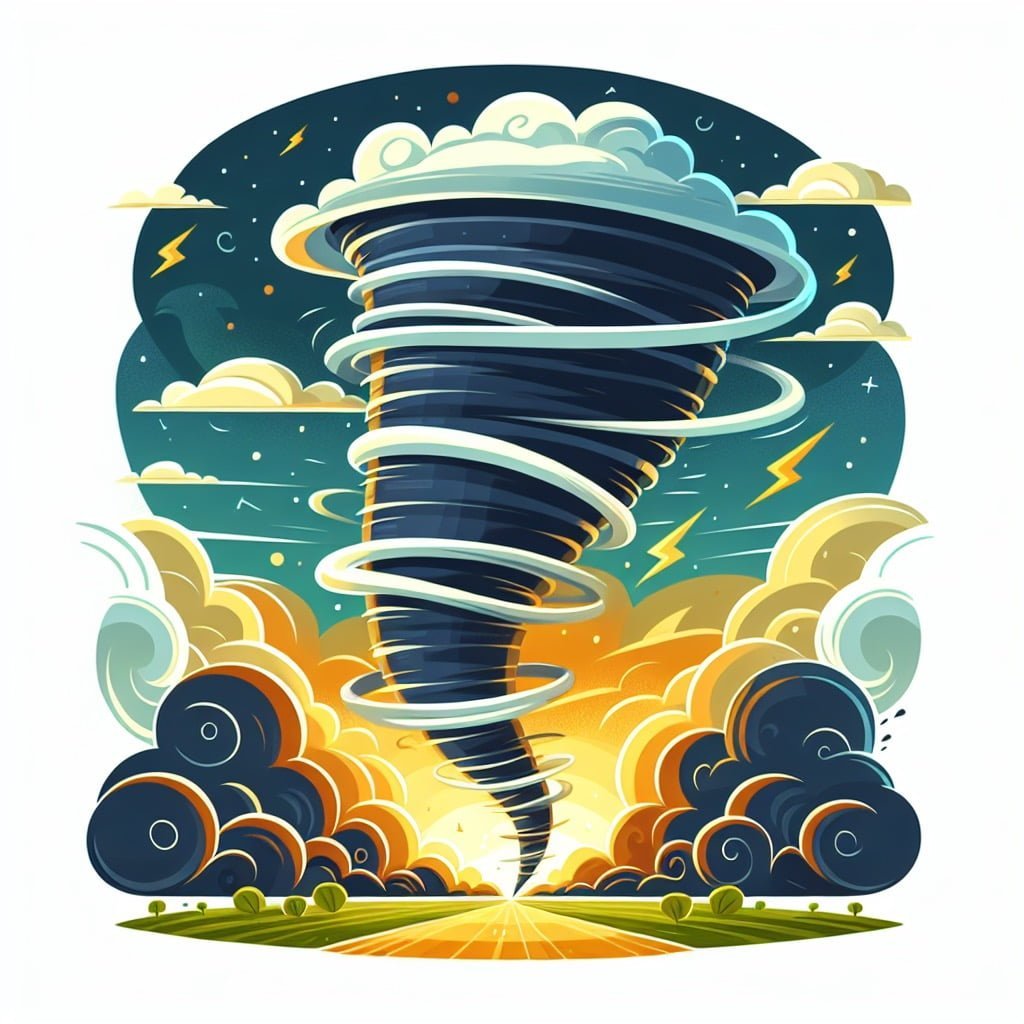Welcome to a whirlwind of fascinating information with our post on Tornado Facts For Kids! Whether you’re a young explorer seeking to uncover the mysteries of these powerful natural phenomena or an older scholar looking to delve deeper into the science behind tornadoes, this post has something for everyone. From how tornadoes form from severe thunderstorms to the incredible wind speeds they can reach, the varying shapes and sizes they come in, and even the distinctive roaring sound they make, each fact will leave you in awe of the forces of nature. Join us on a journey to learn about Tornado Alley, waterspouts, the objects tornadoes can lift, their peak season, the colors they can appear in, and even their surprisingly short duration. Get ready to be blown away by the wonders of tornadoes!
Tornado Facts For Kids
1. Tornadoes Form from Severe Thunderstorms

For younger kids: Tornadoes are born during big thunderstorms with lots of rain and wind.
For older kids: Tornadoes are violent columns of air that extend from severe thunderstorms to the ground, often accompanied by strong winds and heavy rainfall.
Detailed explanation:Tornadoes are a fascinating and powerful force of nature that can be both awe-inspiring and destructive. One of the key things to understand about tornadoes, especially for kids, is how they form. Tornadoes actually originate from severe thunderstorms, which are characterized by strong updrafts of warm, moist air and downdrafts of cool, dry air.
When these contrasting air masses collide, they create an unstable atmosphere that is ripe for the development of a tornado. As the warm air rises and the cool air descends, it can create a rotating column of air known as a mesocyclone. If certain conditions are met, such as strong wind shear and high levels of instability in the atmosphere, this mesocyclone can eventually touch down and form a tornado.
For kids, it’s important to remember that tornadoes can be very dangerous and should be taken seriously. It’s crucial to have a plan in place in case of a tornado warning, such as seeking shelter in a sturdy building or underground shelter. By understanding how tornadoes form from severe thunderstorms, kids can better prepare themselves and their families for severe weather events.
In conclusion, tornadoes are a natural phenomenon that stem from the intense energy of severe thunderstorms. By learning about tornado facts for kids, individuals can gain a deeper appreciation for the power of nature and take steps to stay safe in the event of a tornado.
Tornado Facts For Kids
2. The Fastest Wind Speed in a Tornado Recorded at 302 mph

For younger kids: Tornado winds can be super fast, faster than anything you’ve ever seen!
For older kids: The highest wind speed ever recorded in a tornado was 302 mph in Oklahoma on May 3, 1999, making it the fastest wind speed on Earth.
Detailed explanation:Tornado Facts For Kids are always fascinating to learn about, and one of the most incredible aspects of tornadoes is their incredible wind speeds. The fact that the fastest wind speed ever recorded in a tornado was a staggering 302 miles per hour truly showcases the immense power and force of these natural phenomena.
Tornadoes are rapidly rotating columns of air that extend from a thunderstorm to the ground, and they are capable of producing extremely strong winds that can cause extensive damage to anything in their path. The Enhanced Fujita (EF) scale is used to categorize tornadoes based on the damage they cause, with EF5 being the most severe. Tornadoes with wind speeds exceeding 200 mph are typically classified as EF5 tornadoes, which are incredibly rare and destructive.
The tornado that recorded the fastest wind speed of 302 mph occurred in Moore, Oklahoma on May 3, 1999. This particular tornado was part of a larger outbreak of severe weather that affected several states in the central United States. The incredibly high wind speeds of this tornado resulted in significant destruction, including numerous homes and buildings being completely flattened.
Understanding the extreme wind speeds that tornadoes are capable of generating is crucial for both scientists studying these phenomena and for individuals living in tornado-prone areas to be aware of the potential dangers they pose. By learning more about Tornado Facts For Kids, we can better prepare for and respond to these powerful storms.
Tornado Facts For Kids
3. Tornadoes Come in Different Shapes and Sizes

For younger kids: Tornadoes can look like funnels, ropes, or even elephants!
For older kids: Tornadoes can vary in shape and size, ranging from thin ropes to wide cones, with some even resembling elephants or wedges.
Detailed explanation:Tornadoes are powerful and destructive natural phenomena that can take on a variety of shapes and sizes. It is important for kids to understand that not all tornadoes look the same, as this can help them better prepare for severe weather conditions. The different shapes and sizes of tornadoes are primarily classified based on their intensity and structure.
One common type of tornado is the rope tornado, which is thin and long like a rope. These tornadoes often form during the dissipating stage of a larger tornado and are typically weaker in intensity. Kids should know that rope tornadoes can still be dangerous and should seek shelter when one is spotted.
Another type of tornado is the wedge tornado, which is wider at the base than it is tall. These tornadoes are often associated with violent and destructive storms, making them particularly dangerous. It is important for kids to understand that wedge tornadoes can cause significant damage and should be taken seriously.
Overall, tornadoes can come in a variety of shapes and sizes, each with its own level of intensity and potential for destruction. By learning about the different types of tornadoes, kids can better understand the risks associated with severe weather and how to stay safe during a tornado. Knowing the various shapes and sizes of tornadoes can help kids recognize them when they occur and take the necessary precautions to protect themselves and their families.
Tornado Facts For Kids
4. Tornadoes Make a Roaring Sound Like a Freight Train

For younger kids: Tornadoes are so loud they sound like a big, scary train!
For older kids: Tornadoes emit a distinct roaring noise that resembles a freight train, caused by the high winds swirling debris in the storm’s center.
Detailed explanation:One of the most fascinating and terrifying aspects of tornadoes is the distinctive roaring sound they produce, often described as being similar to that of a freight train. This sound is not just a figment of people’s imaginations; it is a real phenomenon caused by the incredible power and force of a tornado.
When a tornado forms, it creates a rapidly rotating column of air that can reach speeds of up to 300 miles per hour. As this column of air moves across the landscape, it can pick up debris such as dirt, rocks, and even entire buildings, which adds to the loudness of the sound it produces. The combination of high winds and flying debris can create a cacophony that is truly frightening to witness.
The sound of a tornado has been compared to that of a freight train because both produce a deep, rumbling noise that can be heard from a distance. This comparison helps to convey the sheer power and intensity of a tornado to those who have never experienced one firsthand. For children, understanding this comparison can make the concept of a tornado easier to grasp, as they can relate it to something familiar like a train.
In conclusion, the roaring sound of a tornado is a result of the immense power and force it possesses, as well as the debris it picks up as it moves across the landscape. This sound is not only awe-inspiring but serves as a warning to those in its path to seek shelter and stay safe. Learning about tornado facts for kids can help them understand and respect the destructive force of these natural disasters.
Tornado Facts For Kids
5. Tornado Alley is a Region in the Central US Prone to Tornadoes

For younger kids: Tornado Alley is a special place where lots of tornadoes happen!
For older kids: Tornado Alley is a region in the central United States known for frequent tornado occurrences, including states like Texas, Oklahoma, Kansas, and Nebraska.
Detailed explanation:Tornado Alley is a region in the central United States that is known for its frequent occurrences of tornadoes. This area, which spans from northern Texas through Oklahoma, Kansas, Nebraska, South Dakota, and into eastern Colorado, experiences a higher concentration of tornadoes than any other region in the world. The unique combination of warm, moist air from the Gulf of Mexico colliding with cool, dry air from Canada creates the perfect conditions for the formation of these destructive storms.
Tornadoes in Tornado Alley can vary in size and intensity, from smaller, less damaging tornadoes to massive EF5 tornadoes with wind speeds over 200 mph. The most active months for tornadoes in this region are typically from April to June, when warm temperatures and unstable weather patterns are most prevalent.
For kids living in Tornado Alley, it is important to be prepared for severe weather events. They should have a plan in place for seeking shelter during a tornado warning, such as going to a basement or an interior room on the lowest level of their home. It is also essential to have an emergency kit with supplies like water, non-perishable food, a flashlight, and a first aid kit.
By learning about tornado facts for kids, children can better understand the science behind these powerful storms and how to stay safe during severe weather. Education and preparedness are key in ensuring the well-being of individuals living in areas prone to tornadoes like Tornado Alley.
Tornado Facts For Kids
6. Waterspouts are Tornadoes Over Water

For younger kids: Waterspouts are tornadoes that form over oceans, lakes, or rivers!
For older kids: A waterspout is a tornado that occurs over a body of water, like oceans or lakes, created by the same atmospheric conditions as land tornadoes.
Detailed explanation:Tornado Facts For Kids provide interesting information about these powerful weather phenomena. One fascinating fact is that waterspouts are essentially tornadoes that occur over bodies of water. These water-based tornadoes have the same characteristics as their land counterparts, but they form over oceans, lakes, or rivers.
Waterspouts are created in much the same way as tornadoes on land. They typically develop from severe thunderstorms that contain rotating updrafts. As the updraft spins and gathers strength, a column of spinning air forms, extending downward from the cloud to the surface of the water. This rotating column is what distinguishes waterspouts from regular water sprouts, which are simply columns of water drawn upward by strong winds.
Like tornadoes, waterspouts can vary in size and intensity. Some waterspouts are relatively weak and short-lived, causing minimal damage. However, others can be powerful and destructive, posing a significant danger to any vessels in their path. Waterspouts can also transition from water to land, becoming full-fledged tornadoes that can wreak havoc on coastal communities.
Overall, understanding the connection between waterspouts and tornadoes can help kids grasp the immense power of these natural phenomena. Learning about the formation and behavior of waterspouts provides valuable insight into the science of tornadoes and the importance of being prepared for severe weather events.
Tornado Facts For Kids
7. Tornadoes can Lift Heavy Objects and Animals

For younger kids: Tornadoes are so strong they can pick up cars, trees, and even cows!
For older kids: Tornadoes have incredible power to lift and carry heavy objects, such as cars, trees, and even some animals, due to their intense rotational winds.
Detailed explanation:Tornadoes, as powerful and destructive forces of nature, have the ability to lift heavy objects and even animals off the ground. This phenomenon is known to be one of the most fascinating yet terrifying aspects of tornadoes, especially for children who are curious about these natural disasters.
When a tornado forms, it creates an intense vortex of wind that can reach speeds of up to 300 mph or more. This powerful wind speed, combined with the swirling motion of the tornado, creates a strong upward force that is capable of lifting heavy objects such as cars, trees, and even houses off the ground. In some cases, tornadoes have been known to completely level buildings and structures, leaving behind a path of destruction in their wake.
Animals are also at risk during tornadoes, as the powerful winds can easily sweep them up and carry them long distances. This is why it is important for pet owners to have a plan in place for keeping their animals safe during severe weather events, including tornadoes.
For kids who are interested in tornado facts, learning about the ability of tornadoes to lift heavy objects and animals can be both educational and awe-inspiring. It serves as a reminder of the incredible power of nature and the importance of being prepared for extreme weather events. By understanding the science behind tornadoes, children can better appreciate the need for safety measures and precautions when tornadoes are forecasted in their area.
Tornado Facts For Kids
8. Tornado Season Peaks in Spring and Early Summer

For younger kids: Tornadoes mostly happen when it’s warm and sunny outside!
For older kids: The peak season for tornadoes in the US is during spring and early summer, from March to June, when warm, moist air collides with cool, dry air to fuel severe storms.
Detailed explanation:Tornadoes are a fascinating yet dangerous natural phenomenon that captivate the minds of both kids and adults alike. One interesting fact about tornadoes that is often highlighted in educational resources for children is that tornado season typically peaks in the spring and early summer months. This time of year is when the conditions in the atmosphere are most conducive to the formation of these destructive storms.
During the spring and early summer, the clash of warm, moist air from the Gulf of Mexico with cool, dry air from Canada creates the perfect recipe for severe weather, including tornadoes. As the warm air rises and cools, it can create powerful thunderstorms that have the potential to spawn tornadoes. These tornadoes can vary in size and strength, from relatively weak EF0 tornadoes to catastrophic EF5 tornadoes with wind speeds exceeding 200 mph.
For kids learning about tornadoes, understanding the seasonal patterns of tornado activity can help them better prepare for potential severe weather events. By knowing that tornadoes are most likely to occur in the spring and early summer, children can stay informed and be ready to take action if a tornado warning is issued for their area.
Overall, teaching kids about tornado facts, including the peak season for tornadoes, not only educates them about the science behind these powerful storms but also helps them develop a greater awareness and respect for the forces of nature. By instilling this knowledge at a young age, children can learn to stay safe during tornado season and appreciate the importance of preparedness and caution in the face of severe weather.
Tornado Facts For Kids
9. Tornadoes can Vary in Colors, Like Gray, Black, or Red

For younger kids: Tornadoes can come in different colors, not just white!
For older kids: Tornadoes may display varying colors such as gray, black, red, or even multicolored hues based on the debris they pick up while swirling.
Detailed explanation:Tornadoes are a fascinating and terrifying natural phenomenon that can vary greatly in appearance, including their colors. While most people may picture a tornado as a dark gray or black funnel swirling ominously against a stormy sky, tornadoes can actually come in a range of colors, including red.
The color of a tornado is influenced by various factors, such as the time of day, the presence of debris within the funnel, and the type of clouds the tornado is formed from. A tornado may appear red if it is picking up red soil or clay from the ground, giving it a distinct hue. Additionally, the presence of strong winds and debris within the funnel can create a darker, more ominous appearance, leading to the classic gray or black color associated with tornadoes.
For kids learning about tornadoes, understanding that these destructive forces of nature can come in different colors can add an additional layer of intrigue to their study. It is important for children to learn about tornado safety and preparedness, regardless of the color they may appear. By educating themselves about tornado facts, kids can better understand the science behind these swirling storms and how to stay safe in the event of severe weather.
In conclusion, tornadoes can indeed vary in colors, from the more common gray and black to the more rare red hues. By exploring the diversity of tornado colors, kids can deepen their appreciation for the power and unpredictability of these natural phenomena.
Tornado Facts For Kids
10. Tornadoes Don’t Last Long, Typically 10-15 Minutes

For younger kids: Tornadoes are like quick storms that don’t stay for long!
For older kids: Contrary to their destructive power, tornadoes usually last for only about 10-15 minutes on the ground, although some may persist longer under specific conditions.
Detailed explanation:Tornadoes are one of the most fascinating yet destructive natural phenomena on Earth. These swirling columns of air can wreak havoc in a matter of minutes, causing widespread destruction and even loss of life. However, one interesting fact about tornadoes that may come as a surprise to many is that they don’t actually last very long.
In fact, the average lifespan of a tornado is typically only around 10 to 15 minutes. This may seem like a relatively short period of time considering the devastation that tornadoes can cause, but it is important to understand the reasons behind this relatively short lifespan.
Tornadoes form when warm, moist air near the ground meets cool, dry air aloft, creating a rotating column of air. This rotating column can quickly intensify into a powerful tornado, but the conditions that created it in the first place are not sustainable for long periods of time. As the warm air cools and the storm system moves, the tornado gradually loses its strength and eventually dissipates.
Additionally, tornadoes are typically part of larger storm systems, such as thunderstorms or supercells, which have their own lifespans. Once the storm system weakens or moves away from the area, the tornado is no longer sustained and quickly dissipates.
So while tornadoes may be incredibly powerful and destructive, their relatively short lifespan is due to the specific atmospheric conditions that create them and the larger storm systems of which they are a part. This fact about tornado duration is important for kids to understand, as it can help them grasp the science behind these awe-inspiring natural events.
Did you know?
Did you know that tornadoes can be preceded by an eerie green sky caused by sunlight filtering through the heavy rain and hail within the storm?
Summary of Tornado Facts For Kids
Are you fascinated by the power of nature’s most awe-inspiring forces? Look no further than our latest blog post packed with fascinating tornado facts tailored for kids of all ages! From how tornadoes form during severe thunderstorms to the fastest recorded wind speed of 302 mph, your curiosity will be piqued by these incredible phenomena. Discover the different shapes and sizes tornadoes can take, the roaring sound they make like a freight train, and the unique region known as Tornado Alley in the central US. Learn about waterspouts, the lifting power of tornadoes, their peak season in spring and early summer, the varying colors they can display, and their surprisingly short duration. Don’t miss out on this educational and captivating read on tornado facts for kids!
Sources and additional information for Tornado Facts For Kids
WikipediaBritannicaEnvironmental Protection Agency (EPA)National Oceanic and Atmospheric Administration (NOAA)The Nature ConservancyWorld Wildlife FundEarth Day NetworkGreenpeace InternationalJane Goodall InstituteEnvironmental Protection Agency (EPA)World Wildlife Fund – ConservationNature ConservancyGreenpeaceUnited Nations Environment Programme (UNEP)Conservation InternationalEarthwatch InstituteEnvironmental Defense FundSierra Club




